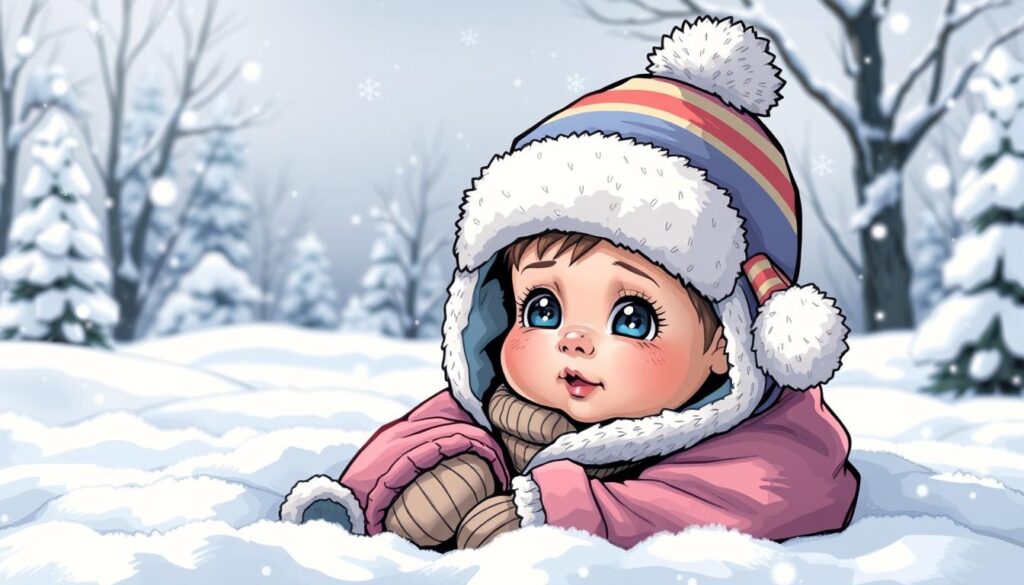Best Tips for Protecting Baby’s Ears in Cold Weather
Did you know that infants are up to 10 times more sensitive to temperature changes than adults? As the winter chill sets in, safeguarding your little one’s delicate ears becomes a top priority. Proper ear protection is crucial to prevent discomfort, frostbite, and potential long-term health issues.
Key Takeaways
- Babies’ ears are highly vulnerable to cold weather due to their thin skin and lack of insulation.
- Exposure to harsh winter elements can lead to frostbite, hearing problems, and other cold-related issues.
- Choosing the right winter hat, layering techniques, and managing indoor temperatures are essential to keep baby’s ears safe.
- Monitoring for signs of discomfort and seeking medical attention when necessary can prevent serious complications.
- Proper winter gear and precautions are crucial for safe outdoor activities and travel with your little one.
Understanding the Importance of Ear Protection in Winter
As the temperature drops and winter sets in, it’s crucial to safeguard your baby’s delicate ears from the harsh elements. Cold weather can have significant effects on a child’s ears, potentially leading to discomfort, infections, and even frostbite. Infants are particularly vulnerable due to their developing bodies and increased temperature sensitivity.
How Cold Weather Affects Baby’s Ears
Exposure to frigid temperatures, wind, and other winter conditions can cause a baby’s ears to become red, irritated, and even painful. The skin on the ears is thin and sensitive, making them prone to drying out, cracking, and becoming more susceptible to infection. Additionally, the cold can constrict blood vessels, reducing blood flow and limiting the body’s ability to maintain a comfortable temperature.
Risks of Exposure to Winter Elements
Prolonged exposure to cold, wind, and wet conditions can lead to a range of health issues for infants. Frostbite, a dangerous condition where the skin and underlying tissues freeze, is a significant concern. Furthermore, the cold can exacerbate existing ear infections or contribute to the development of new ones, which can be particularly troublesome for babies.
Temperature Sensitivity in Infants
Infants have a limited ability to regulate their body temperature, making them more susceptible to the effects of cold weather. Their small size and high surface-to-volume ratio mean they lose heat more quickly than adults, leaving them vulnerable to hypothermia and other cold-related complications. Protecting their ears is crucial to maintaining their overall comfort and health during the winter months.
Essential Cold Weather Gear for Baby’s Ears
Protecting your baby’s delicate ears from the harsh winter elements is crucial. When it comes to essential cold weather gear, look for high-quality items that provide both warmth and comfort. Soft, thermal fabrics like fleece and wool are excellent choices, as they insulate without causing overheating.
A well-fitting hat is a must-have accessory for keeping your baby’s ears cozy. Choose a style that covers the ears completely, ensuring no skin is exposed to the cold wind. Earmuffs can also be a great option, as they provide targeted ear protection without the bulk of a full hat.
- Insulated, fleece-lined hats
- Earmuffs with soft, adjustable bands
- Hooded jackets or sweaters to layer over the ears
When selecting winter gear for your baby, pay close attention to the fit. The items should be snug enough to stay in place, but not so tight that they restrict movement or cause discomfort. Breathability is also important, as you don’t want your baby to overheat and become uncomfortable.
| Product | Price |
|---|---|
| Fleece-lined Baby Hat | $12.99 |
| Adjustable Earmuffs | $9.99 |
| Waterproof Hooded Jacket | $29.99 |
By investing in high-quality winter insulation, cold weather gear, and thermal clothing for your baby’s ears, you can ensure they stay cozy and comfortable during the colder months.

Choosing the Right Winter Hat for Your Baby
As the temperature drops, protecting your baby’s delicate ears from the biting cold becomes a top priority. Selecting the appropriate winter hat is crucial for ensuring your little one’s comfort and well-being throughout the chilly months. From soft, cozy materials to proper fit and age-appropriate styles, there are several factors to consider when choosing the perfect baby winter hats and infant headwear to shield against the cold weather accessories.
Materials to Look For
When it comes to baby winter hats, the material is key. Opt for fabrics that provide warmth without irritating your baby’s sensitive skin. Soft, thermal-regulating materials like wool, fleece, or synthetic blends are excellent choices, as they help retain body heat and prevent heat loss.
Proper Fitting Guidelines
Ensuring a snug, comfortable fit is essential for effective ear protection. The hat should cover the ears without being too tight, allowing for a range of motion and preventing discomfort. Pay close attention to the size and adjustability of the hat to ensure it stays securely in place, even during active play.
Best Hat Styles for Different Age Groups
- Newborns and Infants: Opt for soft, wrap-around styles like beanies or earflap hats that provide full coverage and warmth.
- Toddlers and Young Children: Consider more versatile options like trapper hats or balaclavas that can be adjusted as the child grows and their activity level increases.
By carefully selecting the right winter hat for your baby, you can ensure their ears stay protected and cozy, even in the harshest of winter conditions. With the proper materials, fit, and style, you can help your little one stay comfortable and enjoy the outdoor adventures of the season.
Guarding Against Cold Wind
Protecting your baby’s delicate ears from the biting winds of winter is essential for their comfort and health. One of the most effective ways to shield their ears is by dressing them in windproof jackets with high collars or hoods. These garments create a barrier against the frigid gusts, helping to retain warmth and prevent discomfort.
In particularly windy conditions, consider using face masks or neck gaiters to provide additional protection for your baby’s ears and face. These accessories help to block the wind and keep the sensitive skin around the ears from becoming irritated or chapped. Just be sure that any wind barriers you use don’t obstruct your baby’s breathing or cause them to overheat.
Remember, when it comes to wind protection, the goal is to strike a balance between keeping your little one cozy and avoiding any potential safety hazards. By layering the right cold-weather gear and paying close attention to their comfort, you can help ensure your baby’s ears stay healthy and happy throughout the winter months.
The Role of Thermal Insulation in Ear Protection
Thermal insulation plays a crucial role in safeguarding your baby’s delicate ears during the winter months. By employing effective layering techniques, you can trap warm air close to the body, providing essential protection against the harsh cold weather.
Layering Techniques
To ensure optimal warmth and comfort, follow a strategic layering approach. Start with a thin, moisture-wicking base layer that will keep your baby’s skin dry. Add an insulating middle layer, such as a cozy sweater or fleece jacket, to trap heat. Finally, top it off with a wind-resistant outer layer, like a well-fitted winter hat or a hooded jacket, to shield your little one’s ears from the biting cold.
Temperature Rating Guidelines
When selecting thermal clothing for your baby, pay close attention to the temperature rating guidelines. These guidelines provide valuable information about the appropriate warmth level for specific weather conditions. By choosing garments with the right temperature rating, you can ensure your baby’s ears are adequately protected, whether you’re venturing out in mild winter weather or facing the harshest of winter storms.
| Thermal Clothing | Temperature Rating | Suitable Weather Conditions |
|---|---|---|
| Lightweight thermal base layer | 32°F to 50°F (0°C to 10°C) | Mild winter days |
| Midweight thermal insulation | 20°F to 40°F (-6°C to 4°C) | Colder winter days |
| Heavy-duty thermal layering | Below 20°F (-6°C) | Extreme winter conditions |
By following these layering techniques and temperature rating guidelines, you can ensure your baby’s ears are well-protected and comfortable, even in the harshest of winter weather.
Weather-Appropriate Outdoor Activities
As the temperatures drop and winter arrives, it’s crucial to choose weather-appropriate outdoor activities for your little one. While the fresh air and change of scenery can be beneficial, prolonged exposure to the cold can pose risks to your baby’s delicate ears. To ensure their safety and comfort, it’s best to limit outdoor time during extreme cold and plan activities during the warmer parts of the day.
If the weather is particularly harsh, consider opting for indoor alternatives that allow your baby to explore and play in a cozy, climate-controlled environment. This could include visiting a children’s museum, attending a playgroup, or simply engaging in indoor activities at home.
- When venturing outdoors, regularly check your baby’s ears and face for signs of cold stress or discomfort, such as redness, numbness, or irritation.
- Dress your baby in layers, ensuring their ears are well-protected with a warm, snug-fitting hat or earmuffs.
- Pay attention to wind chill and adjust your outdoor plans accordingly, as strong winds can quickly sap body heat and increase the risk of frostbite.
By being mindful of the weather conditions and prioritizing your baby’s comfort and safety, you can still enjoy the wonders of the outdoors during the colder months. With a little preparation and flexibility, you can create memorable winter experiences for your little one that are both fun and weather-appropriate.

Signs of Cold-Related Ear Discomfort
As the mercury drops and winter winds howl, it’s crucial to remain vigilant for signs of cold-related ear discomfort in your little one. Infants and young children are particularly susceptible to the harsh effects of frigid temperatures, making their delicate ears vulnerable to irritation and potential injury.
Common Symptoms to Watch For
Keep a close eye out for redness, swelling, or an unusually cold sensation in your baby’s ears. If your little one seems irritable and is frequently tugging or pulling at their ears, it may indicate discomfort or pain. These are clear signs that their ears are feeling the effects of the chilly weather.
When to Seek Medical Attention
- If the symptoms persist or worsen, it’s best to seek medical attention promptly. Prolonged exposure to cold can lead to frostbite or other serious cold-related injuries that require immediate care.
- Be on the lookout for signs of infection, such as increased redness, swelling, or discharge from the ears. These warrant a visit to the pediatrician to rule out any underlying issues.
- In severe cases, where your baby’s ears appear severely reddened, swollen, or are causing significant distress, don’t hesitate to contact your healthcare provider or seek emergency medical assistance.
By staying vigilant and acting quickly at the first signs of cold-weather discomfort, you can help ensure your baby’s ear muffs, cold weather symptoms, and infant health monitoring are properly addressed, ensuring their comfort and well-being throughout the chilly season.
Indoor Temperature Management
Maintaining a comfortable indoor environment is crucial for protecting your baby’s delicate ears during the cold winter months. By carefully managing the home temperature, you can ensure your little one stays warm and cozy, safeguarding their sensitive ear canals from the harsh elements.
Aim to keep the room temperature between 68-72°F (20-22°C). This range helps create a soothing, draft-free atmosphere that is ideal for your baby’s indoor warmth. Additionally, consider using a humidifier to prevent the air from becoming too dry, which can further irritate your baby’s ears and nasal passages.
Avoid placing your baby’s crib or play area near cold windows or drafty spots in the home. Instead, use warm, soft blankets to keep them snug and comfortable during sleep, always following safe sleep guidelines. By maintaining a consistent, home temperature control, you can help protect your baby’s delicate ears and ensure their overall well-being throughout the winter season.
Remember, investing in the right clothing and gear is just one piece of the puzzle when it comes to keeping your baby’s ears safe in cold weather. Thoughtful indoor temperature management is equally important to provide the indoor warmth your little one needs to thrive during the winter months.
Travel Safety Tips for Winter Protection
As the colder months approach, it’s crucial to prioritize your baby’s safety when traveling during the winter. From ensuring proper car seat safety to utilizing stroller weather shields, taking the necessary precautions can make all the difference in keeping your little one comfortable and protected from the elements.
Car Seat Safety in Winter Wear
When your baby is bundled up in thick coats and bulky winter attire, it’s important to remove these layers before strapping them into the car seat. Thick clothing can interfere with the car seat’s ability to securely hold your child in place, compromising their safety in the event of a collision. Instead, opt for thin, close-fitting layers that can be worn under the car seat harness.
Stroller Weather Shields
Equipping your stroller with weather shields can provide an additional layer of protection against the biting cold and gusty winds. Look for stroller covers that are designed to keep your baby warm and shielded, while still allowing for proper airflow and visibility. By using these weather-resistant accessories, you can ensure your little one stays cozy and comfortable during your winter outings.







